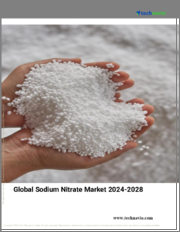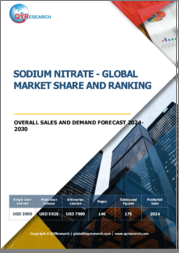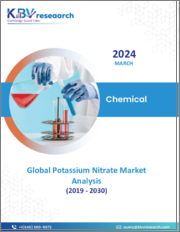
|
시장보고서
상품코드
1617152
세계의 질산나트륨 시장 :등급별, 형태별, 유통 채널별, 용도별, 최종 사용자별, 지역별 세계 분석 예측(-2030년)Sodium Nitrate Market Forecasts to 2030 - Global Analysis By Grade (Food, Industrial, Technical and Other Grades), Form, Distribution Channel, Application, End User and By Geography |
||||||
Stratistics MRC에 따르면 질산나트륨 시장은 2024년 4억 8,420만 달러를 차지하고 예측 기간 동안 복합 연간 성장률(CAGR) 7.3%로 성장하여 2030년에는 7억 3,900만 달러에 달할 것으로 예상되고 있습니다. 비료, 식품 보존료, 화약이나 화약의 제조에 자주 사용됩니다.질산나트륨은 비료중의 질소원이 되어, 식물의 성장을 가속합니다. 또한 유리나 화학약품의 제조에도 공업적으로 이용되고 있습니다. 가열하면 분해하고 산소를 방출합니다.
세계은행이 발표한 데이터에 따르면 미국의 곡물 생산량은 2015년 4억 3,187만 톤에서 2020년에는 4억 3,488만 톤으로 증가합니다.
유기농업의 상승
유기농업의 대두는 소비자와 농업생산자가 점점 자연스럽고 지속가능한 방식을 우선시하고 시장에 큰 영향을 주고 있습니다. 유기농업은 질산나트륨과 같은 합성비료를 피하는 종종 작물 생산에서 질산나트륨의 사용 수요를 줄이고 있습니다. 이러한 유기농법으로의 전환은 건강과 환경에 대한 우려의 고조가 원동력이 되고, 대체 환경 친화적인 비료의 기술 혁신으로 이어져, 질산나트륨 생산자는 시장의 기호 변화에 적응하도록 촉구되었습니다.
환경에 대한 우려
질산나트륨은 토양과 물을 오염시켜 질산염 오염을 일으킬 수 있기 때문에 질산나트륨의 사용을 둘러싼 환경에 대한 우려가 높아지고 있습니다. 파괴, 특히 유아에게 메토헤모글로빈 혈증과 같은 건강 위험을 초래할 수 있습니다. 이러한 환경과 건강에 대한 영향으로 규제가 강화되고보다 지속 가능한 대체품으로의 전환이 추진되고 있지만, 이는 시장 성장을 둔화시킵니다. 이렇게 하면 생산자의 비용이 증가할 수 있습니다.
식품 가공 산업의 성장
식품 가공 산업의 성장이 질산나트륨 수요를 견인하고 있지만, 그 주된 이유는 소시지나 베이컨 등의 식육 제품에 있어서 보존료나 색의 정착제로서 질산나트륨이 하는 역할에 있습니다. 박테리아 증가 식을 억제하여 보존 기간을 연장하고 식품의 안전성을 높이는 데 도움이 됩니다 가공 식품과 조리된 식품의 세계 소비량이 증가함에 따라, 질산나트륨 시장은 특히 식품 제조가 활발해 식품 안전 기준이 엄격한 지역에서 확대되고 있습니다.
원료 가격 변동
탄산나트륨과 질산과 같은 원료 가격의 변동은 시장에 큰 영향을 미칩니다. 이익률 유지하는 데 어려움을 겪기 때문에 소비자에게 가격 상승이나 생산 능력 저하로 이어질 수 있습니다. 성도 있습니다.
COVID-19의 영향:
COVID-19 팬데믹은 공급망의 중단, 노동력 부족, 생산 지연을 유발하여 시장을 혼란시켰습니다. 가공 및 농업 등 특정 분야 수요가 감소했기 때문에 시장은 일시적으로 감속했습니다. 계속 있습니다.
예측기간 동안 비료분야가 최대화될 전망
예측 기간 동안 비료 분야가 가장 큰 시장 점유율을 차지할 것으로 예상됩니다. 즉시 사용 할 수 있는 것에서 편리합니다. 작물의 수확을 촉진하고 식물의 건강을 개선하는 역할을 하는 질산나트륨은 특히 과일, 야채, 기타 질소 수요가 높은 작물에 있어서, 농업 비료의 필수 성분이 되고 있습니다.
예측기간 동안 의약품 분야가 가장 높은 복합 연간 성장률(CAGR)이 예상
의약품 분야는 특히 주사약의 보존이나 특정의 외용 제제의 성분으로서, 특정의약품의 안정제로서 사용되기 때문에 예측 기간 중의 복합 연간 성장률(CAGR)이 가장 높아질 것으로 예상됩니다. 역시 협심증과 같은 증상의 치료에 사용을 지원합니다. 수요가 증가하고 있습니다.
최대 점유율을 차지하는 지역
북미는 농업 비료나 공업 용도로의 사용에 의해 예측 기간 중 최대 시장 점유율을 차지하는 것으로 추정됩니다. 질산나트륨의 화약과 화학약품에의 응용이 성장을 더욱 뒷받침하고 있습니다.
복합 연간 성장률(CAGR)이 가장 높은 지역:
예측 기간 동안 아시아태평양이 가장 높은 성장률을 나타낼 것으로 예상됩니다. 입니다. 또한 인도의 의약품 분야는 급속히 확대되고 있으며, 질산나트륨은 다양한 의약품 제제에 사용되고 있습니다.
무료 맞춤 서비스
이 보고서를 구독하는 고객은 다음 무료 맞춤설정 옵션 중 하나를 사용할 수 있습니다.
- 기업 프로파일
- 추가 시장 기업의 종합적 프로파일링(3개사까지)
- 주요 기업의 SWOT 분석(3개사까지)
- 지역 세분화
- 고객의 관심에 응한 주요국 시장 추계 및 예측, 복합 연간 성장률(CAGR)(주: 타당성 확인에 따름)
- 경쟁 벤치마킹
- 제품 포트폴리오, 지리적 존재, 전략적 제휴에 기반한 주요 기업 벤치마킹
목차
제1장 주요 요약
제2장 서문
- 개요
- 이해관계자
- 조사 범위
- 조사 방법
- 데이터 마이닝
- 데이터 분석
- 데이터 검증
- 조사 접근
- 조사 정보원
- 1차 조사 정보원
- 2차 조사 정보원
- 전제조건
제3장 시장 동향 분석
- 성장 촉진요인
- 억제요인
- 기회
- 위협
- 용도 분석
- 최종 사용자 분석
- 신흥 시장
- COVID-19의 영향
제4장 Porter's Five Forces 분석
- 공급기업의 협상력
- 구매자의 협상력
- 대체품의 위협
- 신규 진입업자의 위협
- 경쟁 기업간 경쟁 관계
제5장 질산나트륨 시장 : 등급별
- 식품
- 산업
- 기술
- 기타 등급
제6장 질산나트륨 시장 : 형태별
- 분말
- 액체
- 입상
- 태블릿
제7장 질산나트륨 시장 : 유통 채널별
- 직접 판매
- 온라인 판매
- 판매자 및 도매업체
제8장 질산나트륨 시장 : 용도별
- 염료와 안료
- 식품 보존
- 금속치료
- 비료
- 부식 억제
- 혈액 질환
- 기타 용도
제9장 질산나트륨 시장 : 최종 사용자별
- 의약품
- 화학약품
- 섬유
- 수처리
- 폭발물
- 기타 최종 사용자
제10장 질산나트륨 시장 : 지역별
- 북미
- 미국
- 캐나다
- 멕시코
- 유럽
- 독일
- 영국
- 이탈리아
- 프랑스
- 스페인
- 기타 유럽
- 아시아태평양
- 일본
- 중국
- 인도
- 호주
- 뉴질랜드
- 한국
- 기타 아시아태평양
- 남미
- 아르헨티나
- 브라질
- 칠레
- 기타 남미
- 중동 및 아프리카
- 사우디아라비아
- 아랍에미리트(UAE)
- 카타르
- 남아프리카
- 기타 중동 및 아프리카
제11장 주요 발전
- 계약/파트너십/협업/합작투자(JV)
- 인수와 합병
- 신제품 발매
- 사업 확대
- 기타 주요 전략
제12장 기업 프로파일링
- Hindustan Chemicals Company
- Chem Service Inc.
- LANXESS
- Anmol Chemicals
- BASF
- Koch Industries, Inc.
- Tessenderlo Group
- Solvay Group
- Trecora LLC
- DKSH
- Nippon Soda Co. Ltd.
- Airedale Chemical Company Ltd.
- Planet Chemicals Pte Ltd
- Deepak Nitrite Ltd.
- SABIC
According to Stratistics MRC, the Global Sodium Nitrate Market is accounted for $484.2 million in 2024 and is expected to reach $739.0 million by 2030 growing at a CAGR of 7.3% during the forecast period. Sodium nitrate (NaNO3) is an inorganic chemical compound that appears as a colorless or white crystalline solid. It is highly soluble in water and is commonly used in fertilizers, as a food preservative, and in the production of explosives and gunpowder. Sodium nitrate serves as a source of nitrogen in fertilizers, promoting plant growth. It also has industrial applications in manufacturing glass and chemicals. When heated, sodium nitrate decomposes, releasing oxygen, which is valuable in various chemical processes.
According to the data released by the World Bank, cereal crop production in the U.S. increased from 431.87 million metric tons in 2015 to 434.88 million metric tons in 2020, whereas, agricultural land witnessed growth from 44.2% to 44.4% of the total land area in the U.S from 2015 to 2020.
Market Dynamics:
Driver:
Rise of organic farming
The rise of organic farming has significantly impacted the market, as consumers and agricultural producers increasingly prioritize natural and sustainable practices. Organic farming often avoids synthetic fertilizers like sodium nitrate, reducing demand for its use in crop production. This shift towards organic methods is driven by growing health and environmental concerns, leading to innovations in alternative, eco-friendly fertilizers, and prompting sodium nitrate producers to adapt to evolving market preferences.
Restraint:
Environmental concerns
Environmental concerns surrounding sodium nitrate use are growing due to its potential to contaminate soil and water, leading to nitrate pollution. This contamination can harm aquatic ecosystems, disrupt biodiversity, and pose health risks such as methemoglobinemia, especially in infants. These environmental and health impacts have led to stricter regulations and a push for more sustainable alternatives, which could slow the growth of the market and increase costs for producers.
Opportunity:
Growing food processing industry
The growing food processing industry is driving the demand for sodium nitrate, primarily due to its role as a preservative and color fixative in meat products, such as sausages and bacon. Sodium nitrate helps in extending shelf life and enhancing food safety by inhibiting bacterial growth. As global consumption of processed and ready-to-eat foods rises, the sodium nitrate market is expanding, especially in regions with high food manufacturing activity and stringent food safety standards.
Threat:
Fluctuating raw material prices
Fluctuating raw material prices, such as those of sodium carbonate and nitric acid, significantly impact the market. Price volatility can lead to unpredictable production costs, affecting profitability for manufacturers. This instability may result in higher prices for consumers or reduced production capacity, as companies struggle to maintain profit margins. Additionally, it can hinder long-term planning and investment in the sector, creating uncertainty within the market.
Covid-19 Impact:
The COVID-19 pandemic disrupted the market by causing supply chain interruptions, labor shortages, and delays in production. Reduced industrial activities and transportation challenges affected the availability of raw materials. Additionally, decreased demand from certain sectors, such as food processing and agriculture, led to a temporary slowdown in the market. However, as economies recover, the market is gradually stabilizing, with renewed demand for sodium nitrate in food preservation and agricultural applications.
The fertilizers segment is expected to be the largest during the forecast period
The fertilizers segment is expected to account for the largest market share during the projection period. Sodium nitrate is a key component in the fertilizer industry, primarily used as a nitrogen source for plants. It is valued for its high solubility, making it quickly available to crops. Its role in promoting crop yields and improving plant health makes sodium nitrate an essential ingredient in agricultural fertilizers, particularly for fruits, vegetables, and other high-nitrogen-demand crops.
The pharmaceutical segment is expected to have the highest CAGR during the forecast period
The pharmaceutical segment is expected to have the highest CAGR during the extrapolated period due to its use as a stabilizer in certain medications, particularly in the preservation of injectable drugs and as a component in certain topical formulations. Sodium nitrate's role as a nitrate donor also supports its use in treating conditions like angina. However, its application is regulated due to concerns about safety and potential toxicity, driving the demand for safer alternatives in the pharmaceutical industry.
Region with largest share:
North America region is estimated to account for the largest market share during the forecast period driven by its use in agricultural fertilizers, industrial applications. Increasing demand for crop nutrients and the growth of the food processing industry are key factors supporting market expansion. Additionally, sodium nitrate's application in explosives and chemicals further fuels its growth. The region's focus on sustainable farming and agricultural practices is expected to continue driving market demand in the coming years.
Region with highest CAGR:
Asia Pacific is expected to register the highest growth rate over the forecast period. Rapid urbanization and rising disposable incomes in countries like China and India are leading to increased consumption of packaged foods, further boosting the market. Furthermore, The pharmaceutical sector in India is rapidly expanding, with sodium nitrite being used in various drug formulations. India is recognized as a leading producer of generic drugs, contributing significantly to the demand for the market.
Key players in the market
Some of the key players in Sodium Nitrate market include Hindustan Chemicals Company, Chem Service Inc., LANXESS, Anmol Chemicals, BASF, Koch Industries, Inc., Tessenderlo Group, Solvay Group, Trecora LLC, DKSH, Nippon Soda Co., Ltd., Airedale Chemical Company Ltd., Planet Chemicals Pte Ltd, Deepak Nitrite Ltd. and SABIC.
Key Developments:
In November 2023, Trecora LLC, acquired the lubricant additives business of Chemtrade based in Lawrence, KS. Chemtrade is one of North America's largest suppliers of sulphuric acid, spent acid processing services, inorganic coagulants for water treatment, sodium chlorate, sodium nitrite and sodium hydrosulphite.
In October 2023, DKSH's Business Unit Performance Materials, a well-established distributor specializing in the distribution of specialty chemicals and ingredients, initiated a significant partnership with Vink Chemicals. This partnership marks a pivotal step in their collaboration, as DKSH is set to provide a comprehensive array of services encompassing business development, marketing, sales, logistics, and distribution for Vink Chemicals' range of biocides.
Grades Covered:
- Food
- Industrial
- Technical
- Other Grades
Forms Covered:
- Powdered
- Liquid
- Granular
- Tablets
Distribution Channels Covered:
- Direct Sales
- Online Sales
- Distributors and Wholesalers
Applications Covered:
- Dyes and Pigments
- Food Preservation
- Metal Treatment
- Fertilizers
- Corrosion Inhibition
- Blood Disorders
- Other Applications
End Users Covered:
- Pharmaceuticals
- Chemicals
- Textiles
- Water Treatment
- Explosives
- Other End Users
Regions Covered:
- North America
- US
- Canada
- Mexico
- Europe
- Germany
- UK
- Italy
- France
- Spain
- Rest of Europe
- Asia Pacific
- Japan
- China
- India
- Australia
- New Zealand
- South Korea
- Rest of Asia Pacific
- South America
- Argentina
- Brazil
- Chile
- Rest of South America
- Middle East & Africa
- Saudi Arabia
- UAE
- Qatar
- South Africa
- Rest of Middle East & Africa
What our report offers:
- Market share assessments for the regional and country-level segments
- Strategic recommendations for the new entrants
- Covers Market data for the years 2022, 2023, 2024, 2026, and 2030
- Market Trends (Drivers, Constraints, Opportunities, Threats, Challenges, Investment Opportunities, and recommendations)
- Strategic recommendations in key business segments based on the market estimations
- Competitive landscaping mapping the key common trends
- Company profiling with detailed strategies, financials, and recent developments
- Supply chain trends mapping the latest technological advancements
Free Customization Offerings:
All the customers of this report will be entitled to receive one of the following free customization options:
- Company Profiling
- Comprehensive profiling of additional market players (up to 3)
- SWOT Analysis of key players (up to 3)
- Regional Segmentation
- Market estimations, Forecasts and CAGR of any prominent country as per the client's interest (Note: Depends on feasibility check)
- Competitive Benchmarking
- Benchmarking of key players based on product portfolio, geographical presence, and strategic alliances
Table of Contents
1 Executive Summary
2 Preface
- 2.1 Abstract
- 2.2 Stake Holders
- 2.3 Research Scope
- 2.4 Research Methodology
- 2.4.1 Data Mining
- 2.4.2 Data Analysis
- 2.4.3 Data Validation
- 2.4.4 Research Approach
- 2.5 Research Sources
- 2.5.1 Primary Research Sources
- 2.5.2 Secondary Research Sources
- 2.5.3 Assumptions
3 Market Trend Analysis
- 3.1 Introduction
- 3.2 Drivers
- 3.3 Restraints
- 3.4 Opportunities
- 3.5 Threats
- 3.6 Application Analysis
- 3.7 End User Analysis
- 3.8 Emerging Markets
- 3.9 Impact of Covid-19
4 Porters Five Force Analysis
- 4.1 Bargaining power of suppliers
- 4.2 Bargaining power of buyers
- 4.3 Threat of substitutes
- 4.4 Threat of new entrants
- 4.5 Competitive rivalry
5 Global Sodium Nitrite Market, By Grade
- 5.1 Introduction
- 5.2 Food
- 5.3 Industrial
- 5.4 Technical
- 5.5 Other Grades
6 Global Sodium Nitrite Market, By Form
- 6.1 Introduction
- 6.2 Powdered
- 6.3 Liquid
- 6.4 Granular
- 6.5 Tablets
7 Global Sodium Nitrite Market, By Distribution Channel
- 7.1 Introduction
- 7.2 Direct Sales
- 7.3 Online Sales
- 7.4 Distributors and Wholesalers
8 Global Sodium Nitrite Market, By Application
- 8.1 Introduction
- 8.2 Dyes and Pigments
- 8.3 Food Preservation
- 8.4 Metal Treatment
- 8.5 Fertilizers
- 8.6 Corrosion Inhibition
- 8.7 Blood Disorders
- 8.8 Other Applications
9 Global Sodium Nitrite Market, By End User
- 9.1 Introduction
- 9.2 Pharmaceuticals
- 9.3 Chemicals
- 9.4 Textiles
- 9.5 Water Treatment
- 9.6 Explosives
- 9.7 Other End Users
10 Global Sodium Nitrite Market, By Geography
- 10.1 Introduction
- 10.2 North America
- 10.2.1 US
- 10.2.2 Canada
- 10.2.3 Mexico
- 10.3 Europe
- 10.3.1 Germany
- 10.3.2 UK
- 10.3.3 Italy
- 10.3.4 France
- 10.3.5 Spain
- 10.3.6 Rest of Europe
- 10.4 Asia Pacific
- 10.4.1 Japan
- 10.4.2 China
- 10.4.3 India
- 10.4.4 Australia
- 10.4.5 New Zealand
- 10.4.6 South Korea
- 10.4.7 Rest of Asia Pacific
- 10.5 South America
- 10.5.1 Argentina
- 10.5.2 Brazil
- 10.5.3 Chile
- 10.5.4 Rest of South America
- 10.6 Middle East & Africa
- 10.6.1 Saudi Arabia
- 10.6.2 UAE
- 10.6.3 Qatar
- 10.6.4 South Africa
- 10.6.5 Rest of Middle East & Africa
11 Key Developments
- 11.1 Agreements, Partnerships, Collaborations and Joint Ventures
- 11.2 Acquisitions & Mergers
- 11.3 New Product Launch
- 11.4 Expansions
- 11.5 Other Key Strategies
12 Company Profiling
- 12.1 Hindustan Chemicals Company
- 12.2 Chem Service Inc.
- 12.3 LANXESS
- 12.4 Anmol Chemicals
- 12.5 BASF
- 12.6 Koch Industries, Inc.
- 12.7 Tessenderlo Group
- 12.8 Solvay Group
- 12.9 Trecora LLC
- 12.10 DKSH
- 12.11 Nippon Soda Co., Ltd.
- 12.12 Airedale Chemical Company Ltd.
- 12.13 Planet Chemicals Pte Ltd
- 12.14 Deepak Nitrite Ltd.
- 12.15 SABIC



















